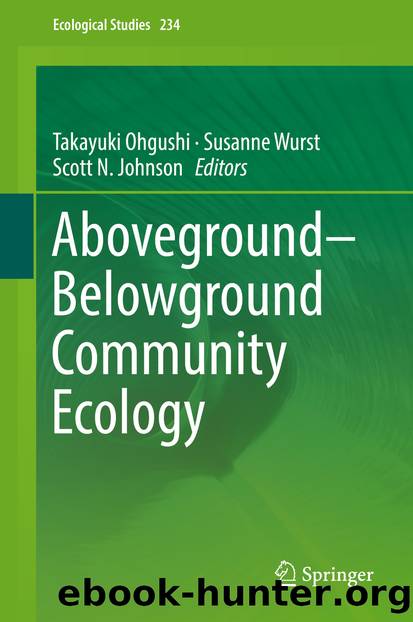Aboveground–Belowground Community Ecology by Unknown

Author:Unknown
Language: eng
Format: epub
ISBN: 9783319916149
Publisher: Springer International Publishing
8.4.3 Root Herbivores
Macrofaunal impact on plants is known in the form of root herbivory by herbivorous soil living insects. Herbivorous soil living insects are found in the orders Orthoptera, Isoptera, Hemiptera, Thysanoptera, Neuroptera, Coleoptera, Diptera, and Lepidoptera (see reviews by Brown and Gange 1990; Mortimer et al. 1999), with the latter three being the most important. Still, within these orders, root feeding is restricted to few families and is done mostly by larval stages. Most root feeding insects have chewing mouthparts, while there are only few known sap suckers. Root feeding insects cover a wide range of host specificity, from highly specialized to generalist species. Which part of the root they feed on depends on their size and their mouthpart characteristics.
Literature on the impact of insect root herbivory on individual plants and plant communities has been reviewed by several authors (e.g., Brown and Gange 1990; Mortimer et al. 1999; Blossey and Hunt-Joshi 2003; Hunter 2001). Primarily, root damage by insect root herbivores impairs water and nutrient uptake as well as storage of resources in root tissues. It can disrupt vascular connection between roots and shoots and can reduce plant stability. Additionally, insect root herbivores have been shown to influence plant interactions with root colonizing microorganisms like the endorhiza bacterial community (Dematheis et al. 2013), AMF (Currie et al. 2006; Bennett et al. 2013), fungal pathogens, or symbiotic rhizobacteria.
Consequences of insect root herbivory for the plant depend on plant tolerance towards root herbivory, which is species-specific but also influenced by environmental factors. Drought and nutrient limitation, for example, can aggravate root herbivory effects. Plant tolerance towards root herbivory involves the reallocation of resources and the regrowth of lost tissues. Occasionally, even over-compensatory regrowth, below- as well as aboveground, occurs. Cases of intolerable insect root herbivore attack, however, result in reduced vegetative and reproductive plant growth. Besides tolerance, plant roots employ several other mechanisms to deal with (insect) root herbivore attack, namely constitutive structural and chemical defenses, inducible chemical defense as well as avoidance (van Dam 2009).
Insect root herbivores can be pests in agri- or horticultural plantings, forests, orchards, or turf sites, and considerably reducing quality and quantity of yields. In diverse natural plant communities, insect root herbivores are thought to influence plant community composition due to their impact on establishment, competitive ability, and reproduction of individual plants. In recent years, modeling approaches by Körner et al. (2014) and Pfestorf et al. (2016) revealed that conflicting results of empirical studies regarding the strength and direction of the root herbivore effect in plant communities may be explained by different root herbivore feeding modes (from unselective to highly plant trait specific) and interactions with resource availability and aboveground grazing.
Download
This site does not store any files on its server. We only index and link to content provided by other sites. Please contact the content providers to delete copyright contents if any and email us, we'll remove relevant links or contents immediately.
| Automotive | Engineering |
| Transportation |
Whiskies Galore by Ian Buxton(41544)
Introduction to Aircraft Design (Cambridge Aerospace Series) by John P. Fielding(32893)
Small Unmanned Fixed-wing Aircraft Design by Andrew J. Keane Andras Sobester James P. Scanlan & András Sóbester & James P. Scanlan(32581)
Craft Beer for the Homebrewer by Michael Agnew(17940)
Turbulence by E. J. Noyes(7720)
The Complete Stick Figure Physics Tutorials by Allen Sarah(7151)
Kaplan MCAT General Chemistry Review by Kaplan(6606)
The Thirst by Nesbo Jo(6452)
Bad Blood by John Carreyrou(6286)
Modelling of Convective Heat and Mass Transfer in Rotating Flows by Igor V. Shevchuk(6232)
Learning SQL by Alan Beaulieu(6045)
Weapons of Math Destruction by Cathy O'Neil(5854)
Man-made Catastrophes and Risk Information Concealment by Dmitry Chernov & Didier Sornette(5674)
Digital Minimalism by Cal Newport;(5398)
Life 3.0: Being Human in the Age of Artificial Intelligence by Tegmark Max(5199)
iGen by Jean M. Twenge(5171)
Secrets of Antigravity Propulsion: Tesla, UFOs, and Classified Aerospace Technology by Ph.D. Paul A. Laviolette(5014)
Design of Trajectory Optimization Approach for Space Maneuver Vehicle Skip Entry Problems by Runqi Chai & Al Savvaris & Antonios Tsourdos & Senchun Chai(4849)
Electronic Devices & Circuits by Jacob Millman & Christos C. Halkias(4760)
